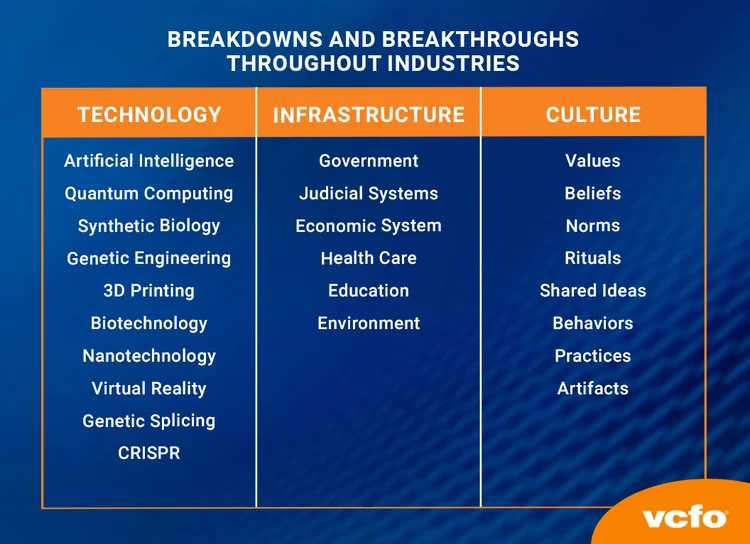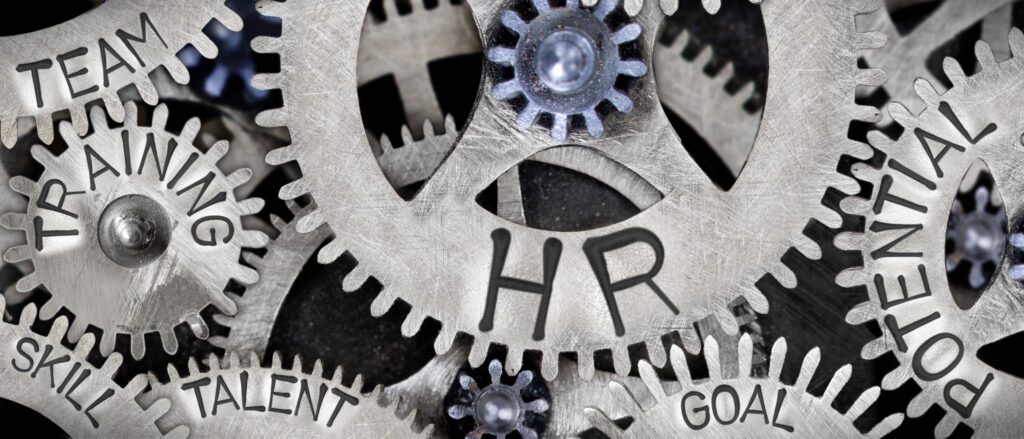
Navigating Your Business Through Change
April 10, 2025
Business as Unusual – Making Sense of Massive Changes
Right now, a convergence of foundational breakdowns and breakthroughs is making it unusually hard for business owners and executives to understand all that is happening, see where things are going, and know what, if anything, they should do about it. That’s because an immense array of ideas, values, norms, practices, beliefs, behaviors, and artifacts around which we’ve constructed our realities and business decisions are undergoing fundamental changes at a startling pace. In this first post in a series that will examine practical steps you can take to guide your business through these shifts successfully, we contextualize the changes taking place, make a case for not sitting on the sidelines, and encourage intentional innovation and exploration to put your business in the best possible position as, and when, the dust settles.
Recognize the meaning & magnitude of changes taking shape.
In many ways, sweeping change is nothing new. Civilization has experienced several reality-shaking shifts before – the Industrial Revolution, the Enlightenment, World Wars I and II, and the rise of the digital age, to name a few – each transforming the world known before them. In every case and with every breakthrough or breakdown to come, a resolution is reached – the dust settles. New realities for how the world works and how people work together eventually emerge. These new realities open worlds of wonder and opportunity for some, while others experience struggle and face obsolescence without innovation.
Today, two major factors are contributing to contrasting feelings of anxiety and excitement about the sweeping changes we’re experiencing. First, multiple reality-shaking breakdowns and breakthroughs are happening simultaneously across technology, infrastructure, and culture. Any one of these breakdowns or breakthroughs could individually turn the world (and business) on its head, and all are emerging at once.

Second, we cannot fully grasp the impacts of these breakthroughs and breakdowns because all are still unfolding, with many having just touched the tip of the iceberg. Take AI for example. Sam Altman, CEO of OpenAI, envisions a five-stage progression of AI capabilities with the potential for reaching level five within 5-10 years. We’re beyond the Chatbots first stage, with the current stage two being Reasoners (AI can work through complex problems step-by-step and show reasoning), followed by Agents (autonomous accomplishment of real-world tasks), Innovators (capable of generating new scientific knowledge and making breakthroughs), and ultimately Organizations (AI systems replicating the complex functions of human organizations).
Don’t resist change. Act to adapt.
Many business owners and executives instinctively resist change because they find comfort in stability. Uncertainty about the future stirs up feelings of anxiety, hesitation, and a tendency to lean into familiar patterns and routines. It’s all too easy for execs to rattle off rationalizations of “we just need to stay the course for now” or “let’s wait until the picture gets a little clearer,” only to soon find their business in an unenviable or completely unsustainable position. Blockbuster, Kodak, Motorola, Myspace, Blackberry, and Xerox represent only a few recognizable names among countless cautionary tales of businesses that sank or suffered mightily because they refused or waited too long to act.
Now is not a time to sit idle and hope for the best. Now is a time to be intentional and vigilant in assessing what these breakdowns and emerging breakthroughs could mean for your business. Former Intel CEO Andy Grove framed it well. His mantra, “Only the Paranoid Survive,” held that constant vigilance and adaptability are essential for survival in a rapidly changing landscape. He argued that companies and leaders must always anticipate and assess disruption, recognizing that success breeds complacency, which can lead to downfall. He also introduced the concept of Strategic Inflection Points—moments when fundamental shifts in technology, competition, or market forces require businesses to radically adapt or risk obsolescence. Now is assuredly one of those moments. Question assumptions, embrace the inevitability of change, and maintain a sense of urgency if you want to remain agile and competitive in the face of uncertainty.
Understand that new realities will call for new ways of doing things.
In the late 1950s to early 1960s, models that predicted economic outcomes faced serious problems related to over-simplicity and unrealistic assumptions. Many of these models relied on linear relationships and assumed that economies operated in a predictable, stable way. However, unexpected fluctuations and inconsistencies in real-world data made these models unreliable for forecasting. In response, economists developed more mathematically rigorous models and integrated advances in statistical methods to improve the accuracy of predictions. These innovations made econometric models more sophisticated and better at reflecting real-world complexities. Then, as computers made their way into universities, economists were able to unlock amazing new insights via the power of nonlinear multivariable equations. As M. Mitchell Waldrop’s book on Complexity noted, “Once they started using computers to solve nonlinear equations, they became aware of strange, wonderful behaviors that their experience with linear systems had never prepared them for.”
As the emerging breakdowns and breakthroughs across technology, infrastructure, and culture advance, many historically tried-and-true business practices, processes, and decision-making frameworks will fragment and ultimately break down as well. For example, the rise of cryptocurrencies and blockchain forced traditional banks to consider digital assets and how financial transactions are secured. Financial firms are increasingly replacing traditional stock-picking methods with algorithmic trading. Workforce management is compelling companies to rethink performance tracking, hiring, and employee engagement strategies to fit a distributed workforce. What does this mean for you? Be intentional and ruthless in seeking out elements of your business that aren’t performing as well as they once did and evaluating the adequacy and effectiveness of your core business systems and frameworks one-year, five-years, and ten-years forward – all in the context of the massive changes taking shape.
Take Charge of Change for Your Business
Tidal waves of change in technology, society, and culture are happening whether we want them to or not and will have increasingly transformative effects (both positive and negative) on our lives and businesses.
- As an owner or executive, ensure that you and your leadership team are devoting ample energy and resources to understanding the monumental scope of these changes and the potential and likely impacts and opportunities they hold for your business.
- Be conscious that “wait and see” biases can put your business at risk and impair its ability to adapt as needed.
- Lastly, challenge long-held conventions in the context of what’s already here and coming soon. Don’t wait for the dust to settle on its own.
—
Would you like a thought partner in this process? Request a Free Consultation to learn how vcfo’s proven CFO and HR leaders can help you evaluate your strategy and prepare and position your business to thrive in the wake of change. We’ve partnered with leaders from over 6,000 businesses in our 29-year history and are ready to put our experience to work for you.





